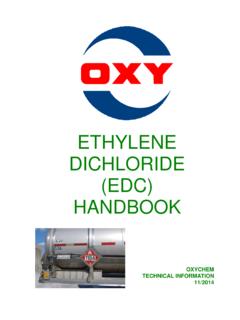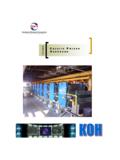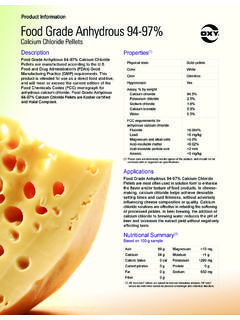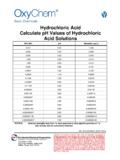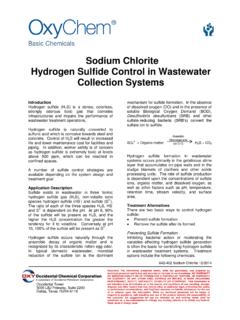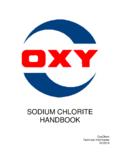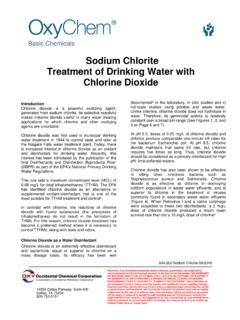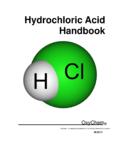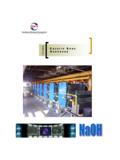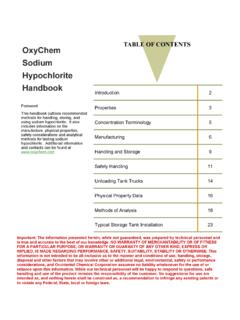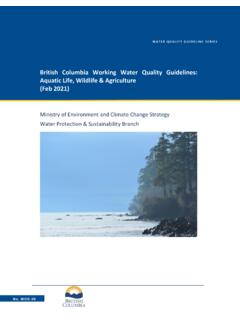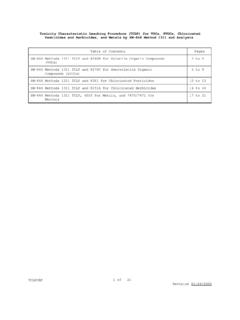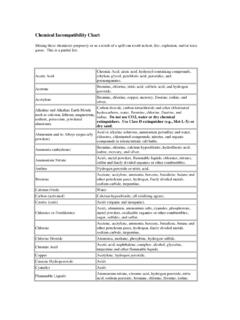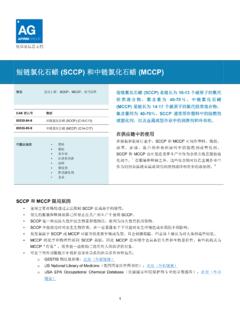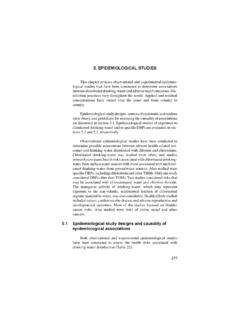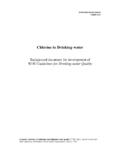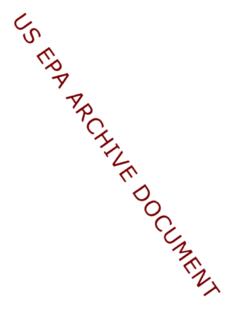Transcription of ETHYLENE DICHLORIDE (EDC) HANDBOOK
1 ETHYLENE DICHLORIDE (EDC) HANDBOOK OXYCHEM TECHNICAL INFORMATION 11/2014 1 Dallas-based Occidental Chemical Corporation is a leading North American manufacturer of basic chemicals, vinyls and performance chemicals directly and through various affiliates (collectively, OxyChem). OxyChem is also North America's largest producer of sodium chlorite. As a Responsible Care company, OxyChem's global commitment to safety and the environment goes well beyond compliance. OxyChem's Health, Environment and Safety philosophy is a positive motivational force for our employees, and helps create a strong culture for protecting human health and the environment. Our risk management programs and methods have been, and continue to be, recognized as some of the industry's best. OxyChem offers an effective combination of industry expertise, experience, on line business tools, quality products and exceptional customer service.
2 As a member of the Occidental Petroleum Corporation family, OxyChem represents a rich history of experience, top-notch business acumen, and sound, ethical business practices. 2 Table of Contents Page Introduction to ETHYLENE DICHLORIDE .. 3 Manufacturing .. 3 ETHYLENE DICHLORIDE (EDC) Uses .. 4 Specifications and Product Grades .. 4 Safety and First Aid .. 4 Hazards .. 4 Respiratory Protection .. 5 Safety Precautions .. 6 First Aid .. 7 Toxicity .. 8 Regulatory .. 8 US Environmental Protection Agency .. 8 US Food and Drug Administration .. 9 World Health Organization .. 9 Handling and Storage .. 9 Shipping .. 9 Barge .. 9 Tank Trailers .. 10 Tank Cars .. 10 Storage & Equipment .. 11 Maintenance of Storage Facilities .. 14 Spills and Precautions .. 15 Technical Data .. 16 Product Sampling .. 16 Physical Properties .. 16 Graphs .. 17 Density v. Temperature .. 17 Vapor Pressure v. Temperature .. 18 Solubility of Water in EDC v. Temperature .. 19 3 MANUFACTURING The chemical compound 1,2-dichloroethane, commonly known as ETHYLENE DICHLORIDE (EDC), is a chlorinated hydrocarbon, mainly used to produce vinyl chloride monomer (VCM, chloroethene), the major precursor for PVC production.
3 It is a colorless liquid with a chloroform-like odor. ETHYLENE DICHLORIDE is also used generally as an intermediate for other organic chemical compounds, and as a solvent. ETHYLENE DICHLORIDE is produced through the iron(III) chloride catalyzed reaction of ethene ( ETHYLENE ) and chlorine. H2C=CH2 + Cl2 Cl-CH2-CH2-Cl In subsequent reactions, notably to vinyl chloride (chloroethene), hydrogen chloride is formed and re-used in a copper(II) chloride catalyzed reaction, to also produce 1,2-dichloroethane from ethene and oxygen. H2C=CH2 + 2 HCl + O2 Cl-CH2-CH2-Cl + H2O OxyChem uses both reactions to manufacture EDC, the first is a direct chlorination reaction (see Figure 1) and the second is an oxychlorination reaction (see Figure 2). Many licenses for variations of each type of process exist today. Figure 1 and 2 are general process descriptions for each type of reaction. Figure 1: Direct Chlorination Reaction 4 Figure 2: Oxychlorination Reaction ETHYLENE DICHLORIDE USES EDC is used primarily as a raw material in the manufacture of vinyl chloride monomer (VCM).
4 The vinyl chloride, in turn is used to manufacture polyvinyl chloride (PVC) resin. EDC is also used as an intermediate in the manufacture of chlorinated and fluorinated compounds. EDC has been used as a solvent in the textile, metal cleaning and adhesive industries. SPECIFICATIONS AND PRODUCT GRADES OxyChem produces and markets Technical Grade ETHYLENE DICHLORIDE at the Geismar, LA facility with a minimum purity of by weight. Material produced and shipped from OxyChem s Geismar, LA plant conforms to the chemical testing requirements of several industrial standards such as the General Use EDC for the ACS Specifications for Reagent Chemicals, 10th Edition; the Food Chemicals Codex, 8th Edition. The manufacturing process for EDC does not incorporate all of the measures specified in the Food and Drug Administration s current Good Manufacturing Practices (cGMP). It is the responsibility of the user to assess their use of EDC products in food, feed, or pharmaceutical related applications and to determine whether appropriate regulatory requirements are being met.
5 OxyChem Technical Grade EDC meets the Military Specification MIL-D-10662-D which was replaced by ASTM D5960-03. OxyChem also manufactures EDC at its Convent, LA plant. Product manufactured at Convent, LA is marketed as Finished Grade ETHYLENE DICHLORIDE with a purity of greater than by weight. OxyChem's Technical Services Department can provide more product information. Call or write the Technical Services Department OxyChem Box 12283, Wichita, KS 67277-2283 800-733-1165, SAFETY AND FIRST AID Hazards EDC is a flammable, toxic chemical and should be handled with extreme care. Personnel should be properly trained in the handling of EDC and should always wear the proper protective equipment when working with, and around EDC. All users 5 Figure 3: Personal Protective Equipment should read the proper Material Safety Data Sheet (MSDS) before handling EDC. The primary health hazard associated with the use of EDC is overexposure due to the inhalation of vapors above the OSHA PEL.
6 The Occupational Safety and Health Association (OSHA) has established Permissible Exposure Limits (PEL) of 50 ppm. The PEL is the allowable average concentration to which workers may be exposed, 8 hours per day, five days a week, without adverse effects. OSHA has also established a Short Term Exposure Limit (STEL) of 100 ppm ceiling for EDC, which is a 15 minute average exposure that should not be exceeded. Also OSHA has established a Peak (5 minutes in any 3 hour period) of 200 ppm. Likewise, the American Conference of Governmental Industrial Hygienists (ACGIH) has established Threshold Limit Values (TLV) of 10 ppm for this product. Work areas employing EDC should be isolated and contained. A local exhaust should provide adequate ventilation to limit solvent vapors to below exposure limits. It is recommended that employees be provided with and required to use chemical impervious clothing, gloves, boots, splash proof goggles and other appropriate protective clothing necessary to prevent any possibility of skin contact with EDC.
7 Material types which may be considered for this service include fire resistant clothing, Barricade, Teflon, Viton, PE/EVAL, CPF3, Responder , and Tychem . Face shields can augment protection provided by splash-proof goggles and safety glasses, but are not intended to replace these safety appliances. (See Figure 3) Respiratory Protection OSHA requires that employees using respirators should be properly fitted and trained in their use. Basically there are 3 types of respirators: 1. Escape: In areas where the unexpected release of EDC vapors may lead to potentially dangerous exposure, appropriate escape respirators should be carried by or be readily accessible to each employee. The most common respirator used for this purpose is the mouthpiece respirator. This respirator contains a single cartridge with a mouthpiece and nose clip. Employees should only use this respirator when escape times are short and airborne concentrations of EDC vapors are low.
8 (See Figure 4) 6 Figure 4: Mouthpiece Respirator (Escape Only) 2. Air Purifying Respirators: Air purifying respirators contain cartridges or canisters of absorbent or reactive material to remove harmful gases from breathing air. These respirators are available as either half face or full-face units. For EDC service, use a cartridge or canister designed for EDC service. (See Figure 5) Where vapor concentration exceeds or is likely to exceed OSHA or NIOSH recommended Exposure Levels, a cartridge or canister respirator should be used. NIOSH has set a 1 ppm eight hour time weighted average for EDC and a 2 ppm fifteen minute short term exposure limit. When working in environments where airborne concentrations are irritating to the eyes, full-face piece respirators should be used. Cartridge or canister respirators are strictly air-purifying devices and must never be used in an oxygen deficient atmosphere (less than oxygen by volume), in environments immediately dangerous to life or health (IDLH), or areas containing unknown concentrations of EDC the NIOSH limit is set at 50 ppm.
9 Figure 5: Full Face Air Purifying Respirator It is important to remember that cartridges and canisters have a limited service life. Conditions such as humidity, chemical concentrations in the workplace, other chemicals in the workplace, and frequency of use will affect cartridge and canister service life. Therefore, an evaluation of workplace conditions should be made to determine the appropriate cartridge/canister replacement schedule. 3. Self-contained Breathing Apparatus: Self-contained breathing apparatus (SCBA) can provide respiratory protection in an oxygen-deficient environment and in situations where unknown concentrations of EDC vapors are present. The SCBA can also provide protection in emergency situations. (See Figure 6) The SCBA is an atmosphere-supplying respirator for which the breathing air source is designed to be carried by the user (OSHA definition).
10 A full-face mask is always used with this type of apparatus. OSHA requires that when wearing the SCBA in an Immediately Dangerous to Life and Health (IDLH) atmosphere, the SCBA must be operated in the pressure demand mode and be certified by NIOSH for a minimum service life of thirty minutes. Escape SCBA devices are commonly used with full face pieces or hoods and, depending on the supply of air, are usually rated as 3 to 60 minute units. Figure 6: Self-Contained Breathing Apparatus OSHA requires that all respirators must be NIOSH approved and shall use breathing gas containers marked in accordance with the NIOSH respirator certification standard, 42 CFR part 84. For further information on regulations pertaining to respirator equipment, see 29 CFR and 30 CFR For additional information see DHHS (NIOSH) Publication No. 2005-100, NIOSH Respirator Selection Logic 2004 or Publication No.
